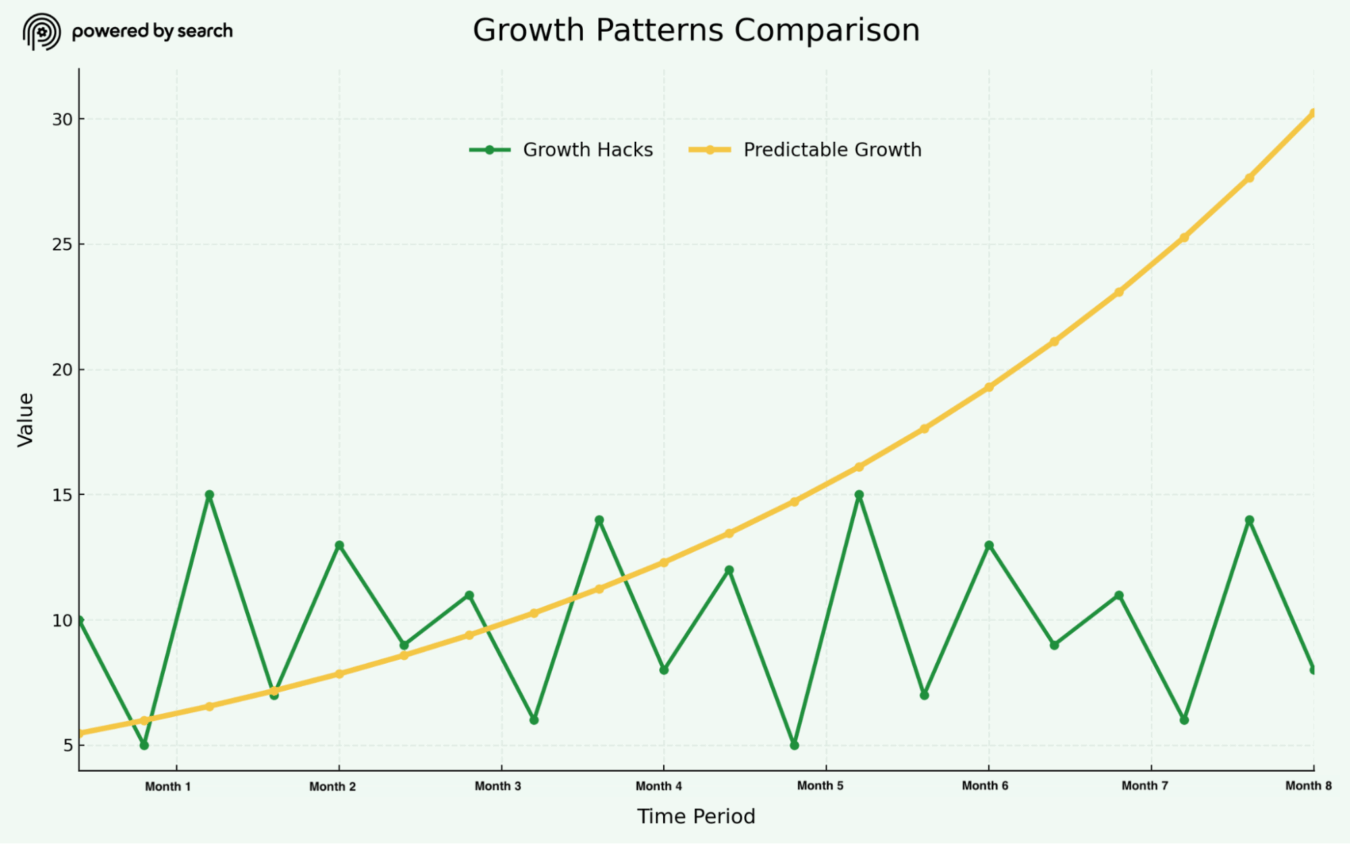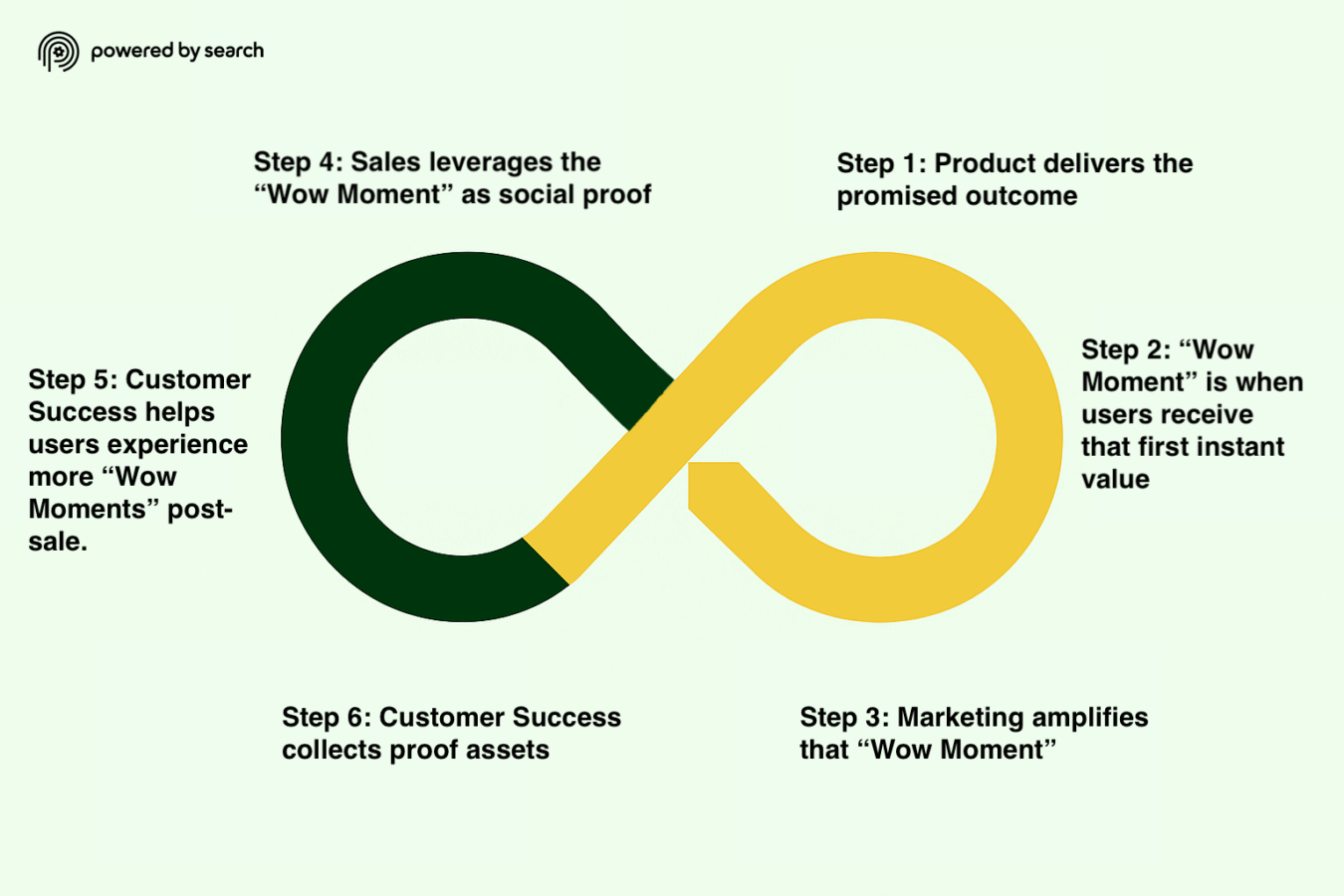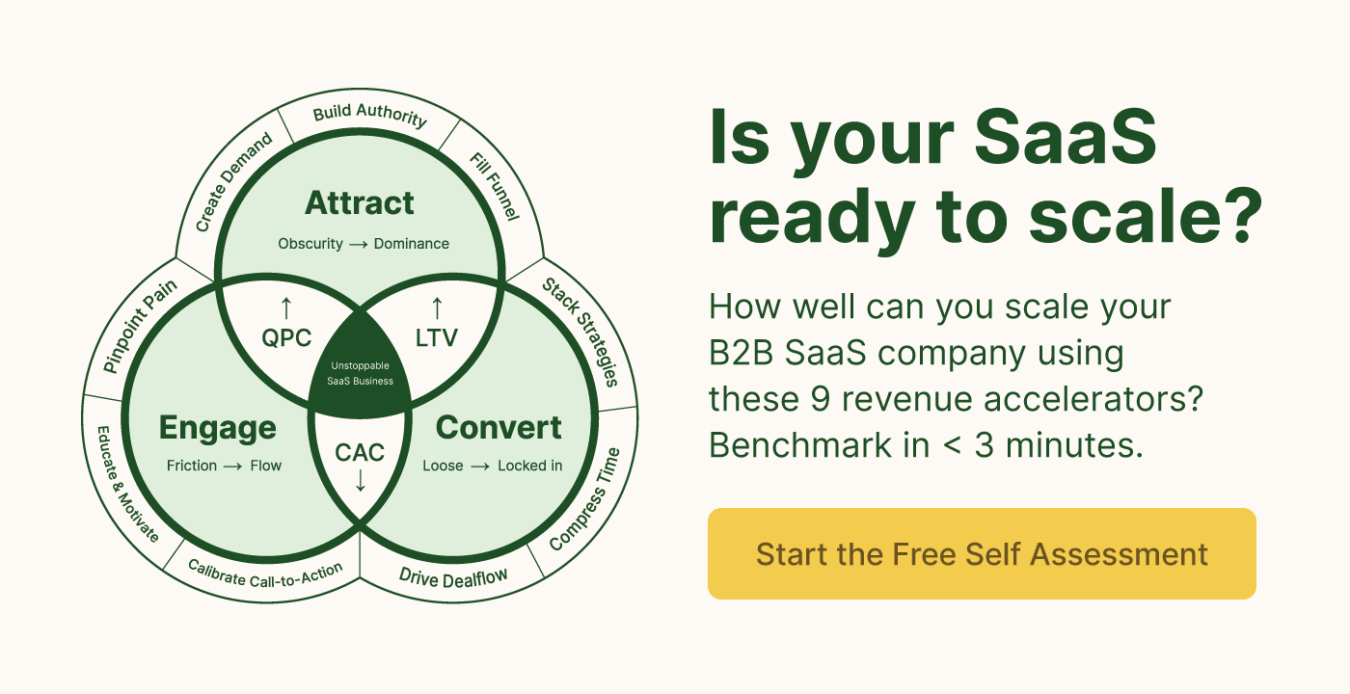The Anti-Growth-Hack Playbook: Compounding B2B SaaS Growth Through Fundamentals
Last updated: September 15th, 2025
“Marketers ruin everything.”
As soon as one marketer discovers a hack that works, they share it, and everyone else starts doing it. After a few weeks, that hack no longer works.
As a result, marketers are constantly jumping from one hack to the next.
It’s exhausting, unsustainable, and eventually causes your growth to flatline.
However, hacks aren’t necessary for genuine growth.
In fact, consistently executing fundamentals on a world class level will lead to profitable, compounding growth, whereas jumping from growth hack to growth hack won’t drive compounding growth.
In this post, we’ll discuss why growth hacking isn’t an effective long term strategy, how to build a compounding growth strategy, and an actionable strategy to break free from the growth hacking mindset for good.
Why Growth Hacks Rarely Survive Two Quarters
You probably remember some of these growth hacks:
- 2019: Hyper‑targeted Facebook Look‑Alike audiences let early adopters collect demos for less than the price of lunch. Twelve months later, CPMs doubled and iOS privacy updates kneecapped conversion tracking.
- 2020: LinkedIn InMail automation promised 40 % acceptance rates. By the time everyone installed the Chrome plug‑ins, LinkedIn throttled connection limits and black‑listed offending domains.
- 2022: Cold‑outreach gurus mined 50,000 email addresses a month until GDPR fines and Google’s spam update torched sender reputations.
- 2024: The “one‑click” AI personalisation craze briefly lifted reply rates before prospects started screenshotting synthetic intros and roasting them on Twitter.
As a result, you’re always searching for the next hack.
If you’re too late, the hack won’t work due to:
- Channel Saturation: CPMs and CPCs spike as everyone learns about the hack.
- Platform Policy Shifts: APIs become restricted, platforms ban automated scraping, or cookie tracking sunsets.
- Buyer Sophistication: Prospects recognize automated outreach patterns and skepticism rises.
This pattern creates an exhausting cycle of searching for loopholes and “hacks,” which pulls you away from executing fundamentals.
As a result, you never build fundamental marketing systems and therefore never achieve compounding ROI.
This uncertainty isn’t just exhausting.
It also makes budgeting and forecasting virtually impossible, and your own success is at the mercy of the latest loopholes.
Predictable Growth Defined
One of the key reasons many SaaS companies never achieve predictable growth is that they lack a clear understanding of the fundamentals that drive predictable growth.
In fact, their “marketing strategy” is a collection of campaigns across a variety of channels that they see their competitors using.
However, this is not an effective SaaS marketing strategy.
We’ve explained that an effective SaaS marketing strategy is more about understanding who your customers are and then meeting them where they are to guide them through the buyer journey.
Over time, you’ll build a flywheel where each marketing campaign works with the others to connect the buyer journey. Compounding growth is the natural result because each campaign improves the efficiency of all other campaigns.
Here’s a more in-depth overview of our Predictable Growth Flywheel:

Our Predictable Growth Methodology is much more sustainable than relying on growth hacks, because it leverages proven, “boring” channels that deliver predictable results.
The results may be slower than growth hacks in the beginning, but unlike growth hacks that decline over time, the Predictable Growth Methodology compounds over time as the channels begin working together to pave a predictable buyer journey.

The core difference between growth hacking and Predictable Growth lies in the fundamentals of understanding the core value of your product and its differentiators, as well as your customers (where they exist, how they currently solve the problem, and how they research solutions).
This leads us to the next question: How do you build this flywheel?
Five Foundational Questions Your Board Will Actually Care About
The basis of any great marketing flywheel is a deep understanding of your product and your customers.
SaaS marketers often think they know the answers to very simple questions about their product, its key differentiators, and their best customers.
Yet when we ask leadership these five questions, many companies have very different responses.
Here are these five questions all of your leaders must align on:
- What painful job do we solve better or cheaper than the status quo? The status quo could be other competitors, DIY spreadsheets, or an in-house full-time employee. Don’t just answer this question with guesses. Ask your customers (or have your sales team ask customers) what they’re doing before buying your product.
- Where does our buyer already go for trusted information? This could be analysts, peer Slack communities, specific newsletters, or trade shows. This is important because it will help you understand where you need to appear to get in front of your ideal customer, which will shape your buyer journey.
- Which event triggers urgency to buy now? Again, ask sales to give you a data driven answer to this question. A trigger event could be new funding, an upcoming audit, a renewal date for the competitor’s contract, or the arrival of a new VP. Campaign calendars should orbit these triggers, not arbitrary quarters.
- What proof erases the two objections we hear most? Ask sales for the two most common objections. Then, ask sales which proof points (case studies, benchmark graphs, ROI calculators, or security certifications) negate these objections.
- How can we monitor progress every week, rather than just celebrating or panicking quarterly? A living scorecard tracks leading indicators (traffic quality, demo‑to‑SQL conversion, activation rate) alongside lagging metrics (new ARR, CAC, churn). Weekly visibility means you iterate while stakes are low.
Once you have the answers to these five fundamental questions, your messaging will better resonate with prospects across all campaigns.
Answering these five questions will also help you understand how users experience the buyer journey, informing you of which channels are the right fit for your company and how to structure CTAs to lead them to the next natural stage of the buying journey.
Building a Flywheel To Maximize LTV and Shorten Payback Period
Marketers often focus on generating more leads and reducing CAC, but at some point, they reach a ceiling where they can’t profitably scale spend because their competition outbids them.
As a result, growth stalls and the company can’t scale. In a desperate attempt to break through this barrier, many marketers turn to growth hacking.
Instead, we focus on attracting the right customers and then maximize LTV and shorten the payback period.
Maximizing LTV and shortening the payback period allows you to outspend competitors, because:
- A single customer is worth more to your company than your competitors (thanks to increasing LTV) and
- You have more cash on hand to invest in advertising (thanks to a shorter payback period).
Most people will agree that increasing LTV and shortening the payback period is ideal, but very few have a systematic process to achieve this.
There are several ways to adjust the offer, but the most effective way to increase LTV and shorten the payback period is by implementing the product-first GTM flywheel.
A product-first GTM flywheel helps users immediately understand the product’s value, making them long-time customers and brand evangelists.
Here’s an overview of the process:
- Product delivers the promised outcome: This could be faster data syncs, clearer dashboards, whatever your core value is.
- Wow Moment is when users receive that first instant value. For an analytics software, it might be the first automated insight. For payroll software, it might be processing the inaugural pay‑run in minutes.
- Marketing amplifies that Wow moment by making it known to more people. First, capture the Wow moment using our testimonial flywheel. This is our systematic approach to collect testimonials in the most impactful moment and then save, organize, and distribute them appropriately. For example, we’ll use these testimonials in blog content, social content, and retargeting ads.
- Sales leverages the Wow proof to qualify customer fit, instantly communicate the value of the product, and remove objections around the perceived likelihood of success.
- Customer Success helps users experience more Wow moments post‑sale. For example, customer success could help them resolve other related issues and ensure they always have a seamless experience. This deepens trust, allowing customer success to earn more testimonials. We actually have an entire process for building testimonial flywheels.
- Customer success collects proof assets, such as video clips, charts, and quotes. These assets feed back into marketing and sales. Nothing is wasted; everything compounds.

Amplifying The Product-First GTM Flywheel
Once you’ve built a product-first GTM flywheel that works, marketing amplifies its reach.
But what is “marketing” from a tactical perspective?
Unlike the growth hacks, we focus on proven SaaS marketing channels:
- SEO (including content marketing and link building)
- Paid ads (Google, Facebook, and LinkedIn ads)
- Email marketing
From an execution perspective, we focus on world class execution of high impact fundamentals.
For example, if you read our playbook on SEO for SaaS, we focus on high impact items like:
- Building a website architecture that allows users and search engines/LLMs to easily find and understand each page on your website.
- Targeting (and refreshing content for) high purchase intent keywords while also following optimization best practices.
- Building links from relevant, high traffic/authority websites to high purchase intent pages.
Many SaaS marketers fail with fundamentals because they don’t execute them at a high enough level, consistently, for a long enough period of time.
If you have tried these channels and they haven’t worked for you, read our guide to SaaS marketing strategies, as we discuss pitfalls that can cause performance to flatline permanently (or at least, until you fix the issue).
Three “Boring” Plays That Can Accelerate Your Flywheel’s Success
We understand that pressure from the board or other executive leaders means that time is a luxury.
This pressure makes growth hacks an attractive alternative to steady growth. Though as we discussed earlier, chasing fast results will catch up with you eventually.
The good news is that, while compounding success doesn’t happen overnight, there are a few things you can do to accelerate success.
Here are three boring plays that work today and will continue to work in the future that we recommend every SaaS company implements.
Strategic Nurture Paths (Email Marketing)
Email is the only marketing channel you own outright, and it still is highly effective for SaaS if you use it thoughtfully.
If you’ve tried email marketing and haven’t found it effective, you might be making one of these mistakes:
- Sending generic nurture sequences to all people rather than segmenting based on pain point and/or ICP.
- Failing to revive dead leads.
- Failing to deliver genuine value in the emails.
When segmented thoughtfully and tied to real user pains, a nurture sequence acts like a silent SDR working nights and weekends. Nurtured prospects also tend to close at a higher ACV because education precedes the pricing slide.
If you need help crafting an effective nurture sequence, you can use our email nurture templates.
We also have a more detailed guide on how we approach building an effective email marketing strategy.
Testimonial Flywheel
Testimonials are a critical part of the product-first GTM flywheel, but very few people put much thought into the testimonial collection process.
In fact, most SaaS companies don’t have a customer testimonial collection process.
However, if you’re a little more intentional and use a defined process, you can optimize both the quality and quantity of testimonials.
Specifically, this is the customer testimonial flywheel we use:
- Capture: Ask for testimonials the moment a customer experiences a win.
- Organize: Tag all testimonials by ICP and pain point so that they’re easy to find for marketing materials and sales calls.
- Inject: Identify friction points within the buyer journey and inject proof points accordingly.
- Expand: You can also use testimonials to upsell existing customers.
- Reactivate: Use your testimonials in retargeting ads to win back churned or dormant accounts.
Weekly Scorecard Meeting
Marketers often become attracted to shiny objects because they don’t have clarity on what needs to be executed.
The Weekly Scorecard solves that by filling the team’s time with fundamentals execution.
The Weekly Scorecard is a single thirty‑minute meeting every Monday, and we’ve seen it save departments six figures in misallocated spend.
The rule is ruthless. You have just five leading indicators and three lagging indicators on one slide.
If a metric turns yellow, an owner drafts a fix by Tuesday. We don’t immediately implement the fix because the drop could be impacted by other factors, such as seasonality.
Therefore, we’ll establish a deadline of when the metric must turn green again. If the metric isn’t reversed by that deadline, we’ll lock in an action plan.
While not all metrics will be reversed within the week, the discipline to address each metric on a weekly basis is important to ensure growth stays on track.
How to Build a Long Term Mindset (And Avoid Falling For The Latest Growth Hack)
The attraction of growth hacks is rooted in a desire for fast results.
However, the most successful businesses take decades to build.
So reframing your growth timeframes from days and weeks to months and quarters is the best way to ensure your team never falls back into the growth hack mindset.
This mindset shift starts by changing the questions you ask yourself.
Here are the questions a “growth hacker” might ask versus a marketer with a long-term mindset:
| Short Term Mindset (Growth Hacker) | Long Term Mindset (Successful Marketer) |
| “How do we go viral this month?” | “Which repeatable motion (blog, webinar, partner email) can we improve by one percent every month for the next year?” |
| “Which new scraping tool should we buy?” | “Which current funnel stage leaks the most qualified prospects, and how do we plug that hole?” |
| “Can we double traffic before Q4?” | “Can we compound qualified traffic eight percent MoM for twelve months?” |
Here are a few of the biggest methods to create and sell online.
Get More Help Developing and Executing a Long-Term Marketing Strategy
Consistently executing the fundamentals at a high level is the most sustainable path to success, but there are plenty of nuances to executing the fundamentals at a world class level.
That’s where Powered By Search comes in.
We’ve developed systems and playbooks specifically for B2B SaaS and pride ourselves on being world class at the fundamentals.
If your marketing strategy isn’t as effective as it needs to be and you want more help identifying and solving inefficiencies so that you can finally escape the growth hacking tactics, reach out to us today.
What you should do now
Whenever you’re ready…here are 4 ways we can help you grow your B2B software or technology business:
- Claim your Free Marketing Plan. If you’d like to work with us to turn your website into your best demo and trial acquisition platform, claim your FREE Marketing Plan. One of our growth experts will understand your current demand generation situation, and then suggest practical digital marketing strategies to hit your pipeline targets with certainty and predictability.
- If you’d like to learn the exact demand strategies we use for free, go to our blog or visit our resources section, where you can download guides, calculators, and templates we use for our most successful clients.
- If you’d like to work with other experts on our team or learn why we have off the charts team member satisfaction score, then see our Careers page.
- If you know another marketer who’d enjoy reading this page, share it with them via email, Linkedin, Twitter, or Facebook.
